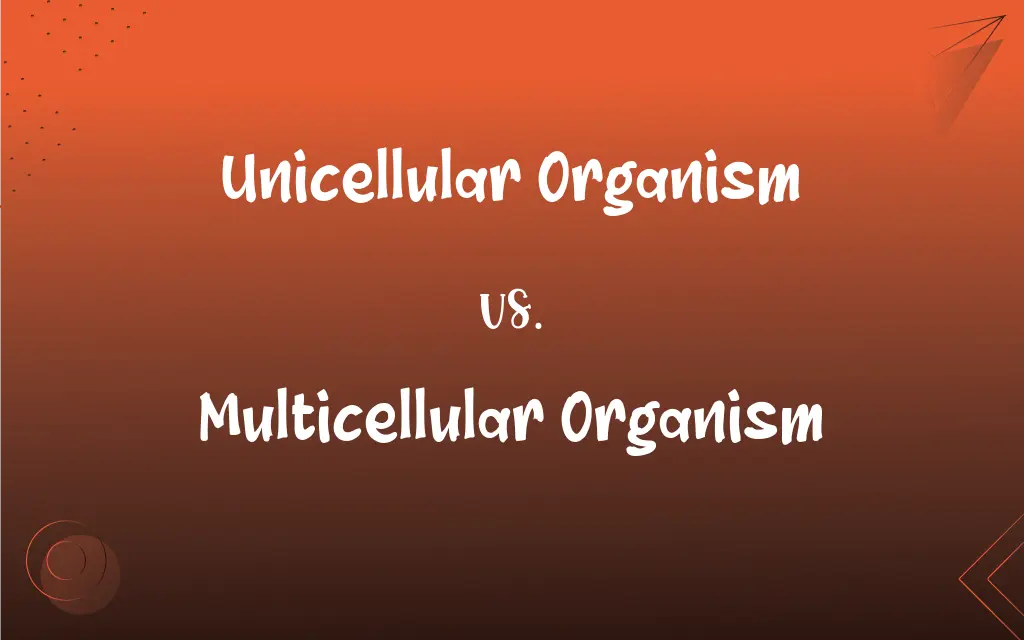Unicellular Organism vs. Multicellular Organism: What's the Difference?
Edited by Janet White || By Harlon Moss || Updated on October 3, 2023
Unicellular organisms are composed of a single cell, like bacteria. Multicellular organisms have multiple cells, like humans.

Key Differences
Unicellular organisms are entities that consist of a single cell which performs all vital functions. Multicellular organisms, contrastingly, comprise multiple cells that collaborate to sustain life, where different cells have varied and specialized functions.
The life and operations of unicellular organisms are regulated within a singular cellular structure, navigating its existence independently. Multicellular organisms, however, exhibit complex intercellular communication, coordination, and task division among numerous cells.
Adaptation in unicellular organisms is typically straightforward, with immediate changes affecting the entire entity directly. Multicellular organisms exhibit complex adaptive strategies, often involving intricate alterations across numerous cells and systems.
The survival strategy of unicellular organisms generally involves adapting to and withstanding environmental challenges singularly. Conversely, multicellular organisms deploy varied survival strategies, often involving specific systems or organ responses.
Unicellular organisms reproduce, often through binary fission, creating identical or nearly identical offspring. Multicellular organisms can employ varied, often more complex, reproductive strategies, involving multiple cells and sometimes complex life cycles.
ADVERTISEMENT
Comparison Chart
Basic Definition
An organism with one cell
An organism with many cells
Complexity
Generally simpler structures
More complex structures
Specialization
One cell performs all functions
Cells often have specialized functions
Reproduction
Often asexual reproduction
Can be asexual or sexual reproduction
Adaptability
Adaptations affect the whole organism directly
Adaptations may involve complex systemic changes
ADVERTISEMENT
Unicellular Organism and Multicellular Organism Definitions
Unicellular Organism
Unicellular organisms can carry out all necessary life processes within a single cell.
Amoebas, a type of unicellular organism, hunt food independently.
Multicellular Organism
A multicellular organism consists of multiple cells, often with varied functions.
Humans are multicellular organisms with numerous cell types.
Unicellular Organism
A unicellular organism is a life form that consists of only one cell.
The bacterium Escherichia coli is a unicellular organism.
Multicellular Organism
Multicellular organisms can exhibit complex behaviors and coordination.
Multicellular organisms like birds can exhibit migratory behaviors.
Unicellular Organism
They generally have simpler structural and functional complexity compared to multicellular entities.
The unicellular organism Plasmodium causes malaria in humans.
Multicellular Organism
Multicellular organisms exhibit a division of labor among different cell types.
In multicellular organisms like dogs, specific cells form tissues and organs.
Unicellular Organism
These organisms reproduce by dividing their single cell into two.
The unicellular organism Paramecium reproduces by binary fission.
Multicellular Organism
These organisms often have complex, organized structures like organs.
The heart in multicellular organisms like whales pumps blood throughout the body.
Unicellular Organism
Unicellular organisms often exist as independent entities.
A yeast cell, a unicellular organism, can live and reproduce on its own.
Multicellular Organism
They can reproduce sexually, involving specialized reproductive cells.
Plants, multicellular organisms, can reproduce through seeds.
FAQs
What is a unicellular organism?
A unicellular organism is an entity consisting of a single cell, performing all vital functions independently.
How do multicellular organisms develop?
Multicellular organisms develop through processes like cell division, differentiation, and specialization.
What are the levels of organization in multicellular organisms?
Multicellular organisms have levels of organization like cells, tissues, organs, and systems.
How do unicellular organisms reproduce?
Unicellular organisms typically reproduce asexually, often through binary fission.
What is a multicellular organism?
A multicellular organism is made of multiple cells, which may have different structures and functions.
What factors affect the survival of unicellular organisms?
Factors like nutrient availability, temperature, and pH affect the survival of unicellular organisms.
Are all unicellular organisms prokaryotic?
No, unicellular organisms can be prokaryotic or eukaryotic.
Can multicellular organisms regenerate?
Some multicellular organisms can regenerate parts of their body, but it varies widely among species.
What are examples of multicellular organisms?
Examples of multicellular organisms include humans, animals, and plants.
How do unicellular organisms obtain food?
Unicellular organisms obtain food through various means, such as absorption, phagocytosis, or photosynthesis.
How do multicellular organisms coordinate functions?
Multicellular organisms coordinate functions through various mechanisms, including nervous and hormonal signaling.
How do multicellular organisms reproduce?
Multicellular organisms can reproduce sexually or asexually, depending on the species.
What are examples of unicellular organisms?
Examples of unicellular organisms include bacteria, yeast, and amoebas.
What is the lifespan of multicellular organisms?
The lifespan of multicellular organisms varies significantly, ranging from days to centuries, depending on the species.
How do unicellular organisms eliminate waste?
Unicellular organisms often eliminate waste by transporting it across the cell membrane.
Can unicellular organisms live in extreme environments?
Yes, certain unicellular organisms, like extremophiles, thrive in extreme environments.
Can multicellular organisms be microscopic?
Yes, some multicellular organisms, like certain algae and fungi, can be microscopic.
Do unicellular organisms have organelles?
Yes, many unicellular organisms, especially eukaryotes, have organelles to perform various functions.
Do multicellular organisms show cell specialization?
Yes, multicellular organisms often exhibit cell specialization, where cells have specific roles.
Can unicellular organisms cause diseases?
Yes, some unicellular organisms, like certain bacteria and protozoa, can cause diseases.
About Author
Written by
Harlon MossHarlon is a seasoned quality moderator and accomplished content writer for Difference Wiki. An alumnus of the prestigious University of California, he earned his degree in Computer Science. Leveraging his academic background, Harlon brings a meticulous and informed perspective to his work, ensuring content accuracy and excellence.
Edited by
Janet WhiteJanet White has been an esteemed writer and blogger for Difference Wiki. Holding a Master's degree in Science and Medical Journalism from the prestigious Boston University, she has consistently demonstrated her expertise and passion for her field. When she's not immersed in her work, Janet relishes her time exercising, delving into a good book, and cherishing moments with friends and family.































































